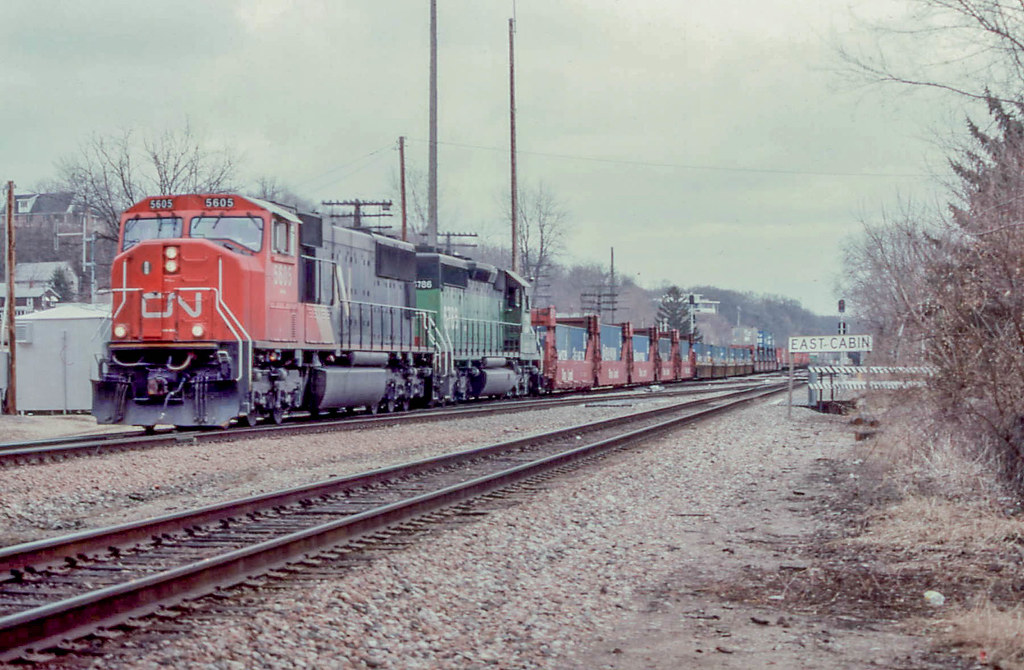
The train observation spot in East Dubuque, located at the intersection of Canadian National (CN) and BNSF Railway lines, offers enthusiasts a prime vantage point to watch a variety of freight trains. Nestled along the scenic Mississippi River, it provides a unique blend of industrial and natural views.
Photos
Sign in to upload photos
No Photos Yet
Be the first to share photos of this location!
East Dubuque (CN/BNSF) – East Dubuque, Illinois, USA | Train Spotting Location
Trainspotting Experience
Most railfans set up on the public walkways and pull-offs along Sinsinawa Avenue or the parallel riverside access road. From these spots you can watch BNSF trains burst from the east portal of the former CB&Q tunnel, roll over the diamond, then accelerate toward the Mississippi bridge less than a mile west. CN trains, arriving on the north–south line, ease down a 1 % grade, clatter across the same diamond, then curve sharply into their own tunnel beneath U.S. 20. Expect wheel squeal, echoing horn choruses, and ground-shaking vibration as locomotives wrestle riverbank curvature at 25–35 mph. On busy days the meet times are tight, so it’s common to witness one crew waiting on the signal while another thunders through—perfect for catching head-on, broadside, and trailing views in a single session.
Landscape, Setting & Local Atmosphere
East Dubuque sits at the foot of steep limestone bluffs where the Driftless Area meets the Mississippi floodplain. The rail lines thread a narrow shelf between rock wall and river, giving viewers unobstructed sightlines but very little ambient noise—aside from locomotives and barges, you’ll mostly hear wind in cottonwoods and distant church bells from Dubuque, Iowa, across the water. Spring brings fresh green along the bluffs; autumn paints the hardwood canopy gold and scarlet, framing locomotives in natural color. Morning fog can linger over the river, adding atmosphere but occasionally obscuring the diamond; by midday the sun often burns it off, revealing crystal-clear views of distant bridges and wooded ridges.
Type & Frequency of Train Activity
BNSF’s Aurora Subdivision handles an average of 45–50 trains per 24 hours. Expect long intermodal stacks bound for the Pacific Northwest, unit grain drags, crude oil blocks, mixed manifests, and occasional business specials. Motive power is typically GEVOs and EMD SD70ACe/SD70MAC units, with Distributed Power Units common on heavier tonnage.
Canadian National moves roughly 10–14 trains daily on the former Illinois Central main. Traffic is a mix of manifest freights, ethanol, grain, and seasonal coal loads, often led by CN or IC-heritage SD70 series locomotives; foreign power from CSX, UP, and KCS appears regularly on run-throughs. No scheduled passenger service currently uses the diamond, but westbound Amtrak’s California Zephyr can be glimpsed across the river on the ex-Milwaukee Road line in Iowa at predictable mid-afternoon times.
Best Angles for Photos & What Railfans Enjoy Most
• East-facing morning shots: position just west of the diamond for low sun reflecting off BNSF noses exiting the tunnel.
• Midday overheads: a short public sidewalk on U.S. 20 offers a higher viewpoint, ideal for capturing both tunnels, river backdrops, and downtown Dubuque’s skyline across the water.
• Golden-hour silhouettes: late afternoon sun behind the bluffs backlights southbound CN trains, producing dramatic profiles with river glints.
Telephoto lenses (200–400 mm) compress the curves, while wide angles (24–35 mm) emphasize bluff height and tunnel mouths. Night photography is popular too; constant traffic and well-spaced signal masts make for striking long-exposure light trails.
Historical or Cultural Relevance
The BNSF tunnel dates to 1868 construction by the Chicago, Burlington & Quincy, engineered to maintain a low-grade river route from Chicago to Denver. Just yards away, the Illinois Central’s “Dunleith & Dubuque Bridge” line opened in 1868 as one of the first rail crossings of the Mississippi north of St. Louis. The current steel girder bridge visible west of the site replaced earlier swing spans in 1899 and remains a vital freight artery. Local lore recalls steamboat pilot Samuel Clemens (Mark Twain) describing the area’s “garden of bluffs and rails” while navigating the river. Today, city heritage signs along nearby Riverwalk detail these 19th-century engineering feats.
What Makes This Spot Different
Few Midwestern locations combine:
- A diamond of two Class I mains in continuous use.
- Dual tunnels framed by river and bluff within a quarter-mile.
- Safe, legal public viewing at track-level distance without obstructions.
Add in high train volume, frequent horn action due to the crossing, and the sweeping Mississippi backdrop, and East Dubuque offers a layered sensory experience that typical flatland grade crossings cannot match.
Seasonal Information
For train observation in East Dubuque, spring and fall offer mild weather and scenic views along the Mississippi River. Summer provides long daylight hours, while winter offers picturesque snowy landscapes. Check for special rail events and be prepared for potential weather-related delays in winter.
Other Interesting Locations
Looking for more spots? Browse the complete list of train spotting locations.
Quick Information
Country
USA
Region / State / Province
Illinois
City
East Dubuque
Spot Type
Junction
Best Times
The best hours to observe trains in East Dubuque are during peak freight activity, typically early morning (6-9 AM) and late afternoon to evening (4-7 PM).
Access & Amenities
Parking
Not available
Shelter
Not available
Restrooms
Not available
